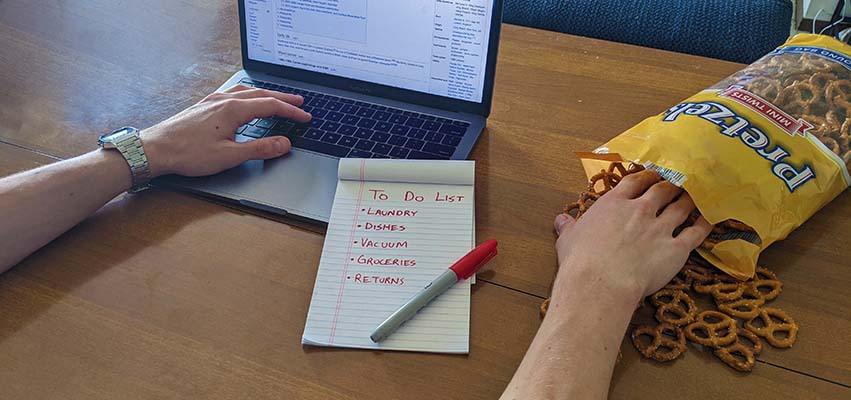
“Stress? What stress?!” you squeak, anxiously spooning the last bites of a newly-opened Ben & Jerry’s pint of ice cream into your mouth. We’ve all been there (including me, the dietitian) and there is nothing to be ashamed of. It is common to reach for food in times of distress because eating is soothing and helps us cope with our emotions. Food, particularly carbohydrate-rich food, causes the release of serotonin, a neurotransmitter in our brain that generates feelings of calm and happiness.
Since the pandemic hit, I’ve seen a tremendous increase in the number of people struggling with emotional eating. Between the requirements of working from home, the uncertainty of spreading the virus and the social isolation, our collective stress has reached a new high—and we’ve got the overloaded snack cabinet to prove it! Eating calms us down in moments of stress, provides a release and helps us feel better, albeit temporarily.
While eating may lessen the immediate emotional burden of these stressors, it also enables us to ignore our feelings and never actually deal with the problem. So, the problem keeps surfacing, we keep eating to suppress it, and the cycle goes on and on. Here are two ways to get yourself out of the habit of turning to food when emotionally distraught:
Examine Your Feelings
Learn to sit with your feelings by asking yourself two questions:
- What am I feeling? When you start to feel a surge of emotion and catch yourself reaching for food to soothe, pause for a minute and become fully aware of what you are feeling. Are you feeling stressed, angry or sad? Naming our emotions is often the hardest part. We’re good at sweeping them under the rug, but we must do this if we want to move forward. Also, notice the physical sensation caused by your emotion. Maybe you feel your heart pounding and shortness of breath when you’re anxious. Perhaps you feel tension in your neck and shoulders when you are nervous. It’s important to understand how these emotions make you feel physically—this helps you learn how to tolerate these feelings, rather than turning to food to cope.
- What do I need? Now ask how you can fulfill this need and deal with this feeling without turning to food. If you need to feel connection, ask for more time with your spouse, a friend or family member. If you need rest, you might ask your boss for flexible hours at work or see if someone can watch your kids for a few hours. There’s usually a storyline underlying these emotions. It’s our job to read it and figure out what we really need.
Take a Timeout
Emotional eating is a learned habit and an automatic behavior. The minute we feel stressed (or whatever emotion drives you to eat) we immediately turn to food. Over time, this creates an association between feeling stressed and eating food. However, this association can be broken by interfering with its process.
The next time you start to reach for food, stop and give yourself 10 minutes to sit with your emotions. Practicing the first tip is a great way to fill this time. If your desire to eat continues to be overwhelming and you choose to eat, that’s okay. You are still making progress because you are working to break that association stress and eating by at least pausing instead of reacting.
Notice how I haven’t mentioned anything about the types of foods to eat or not eat. That’s because stress eating isn’t really about the food; it’s about the emotion behind your drive to eat. Sitting with your feelings is uncomfortable and hard work, but it’s good work—the kind that creates lasting changes in your eating habits. PM
Ashley Thomas, MS, RD, is a private practice dietitian and owner of Ashley Thomas Nutrition. Learn more at ashleythomasnutrition.com.
- Log in to post comments

